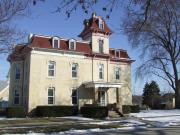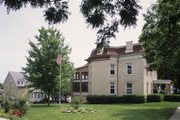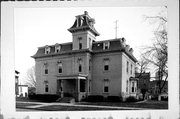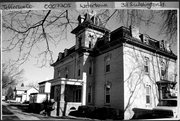Property Record
311 S WASHINGTON ST
Architecture and History Inventory
| Historic Name: | HENRY MULBERGER, SR. HOUSE |
|---|---|
| Other Name: | |
| Contributing: | Yes |
| Reference Number: | 7205 |
| Location (Address): | 311 S WASHINGTON ST |
|---|---|
| County: | Jefferson |
| City: | Watertown |
| Township/Village: | |
| Unincorporated Community: | |
| Town: | |
| Range: | |
| Direction: | |
| Section: | |
| Quarter Section: | |
| Quarter/Quarter Section: |
| Year Built: | 1876 |
|---|---|
| Additions: | |
| Survey Date: | 1986 |
| Historic Use: | house |
| Architectural Style: | Second Empire |
| Structural System: | |
| Wall Material: | Cream Brick |
| Architect: | |
| Other Buildings On Site: | |
| Demolished?: | No |
| Demolished Date: |
| National/State Register Listing Name: | South Washington Street Historic District |
|---|---|
| National Register Listing Date: | 11/26/2003 |
| State Register Listing Date: | 7/18/2003 |
| National Register Multiple Property Name: |
| Additional Information: | This house was the long time home of the Mulberger family: Henry, Charles, and Arthur, all mayors of Watertown, and businessmen. The Mulberger family lived here between c. 1872 and at least 1930. Henry Mulberger, Sr. came to Watertown in 1848. He operated a store and studied law, eventually becoming a prominent attorney and mayor. Henry Mulberger Jr. was a businessman who was affilitated with the Globe Milling Company and a cashier at the Wisconsin National Bank. He was also mayor of Watertown. Arthur Mulberger was an attorney and served as mayor between 1910 and 1914, and Charles Mulberger was a businessman who served as mayor between 1920 and 1924 and was later a state senator. This house is significant for local history under National Register criterion B because it was associated with several members of the Mulberger family, prominent citizens in law, commerce and politics. Tradition states that the Mulberger family in Germany were long-time public servants and that tradition was carried out in America. The Mulberger family contributed to the commercial development of the community in the early store Henry Sr. operated, and the Globe Milling Co., which Henry Jr. was affiliated with. They were also contributors in the field of legal services, since Henry Sr. and Arthur were attorneys. But their most important contribution to the community was their family willingness to serve as mayor. In a community which rarely re-elected men to additional terms as mayor, the fact that all the Mulbergers associated with this house were successful mayors, speaks to the family's popularity in the community. As a group, they contributed significantly to the development of government in Watertown. This house, as the family's long-time home, is significant because of its association with the Mulbergers. Dominated by a mansard roof, three-story tower with round arched dormers, this French Second Empire styled house, built in the 1870s for the prominent local attorney Henry Mulberger, features a concave mansard roof with triangular pedimented and segmental arched dormers, Italianate influenced bracketed overhanging eaves on the house and on the tower, and raised brick segmental arched window heads with articulated keystones over long narrow windows. A bay window decorated with bracketed eaves and paneled apron and an open flat roofed dark brick porch leads to the double leafed, arched entrance door. A steep gable roofed brick coach house (54-33) with cross gable at the front, wooden cupola and roof dormers located at the rear of the house has been converted to a residence. The cream brick Mulberger house has been altered by the addition of the dark brick porch, of replacement windows and by the severe sandblasting of the exterior that has left an excessively rough brick surface. Originally a porch extending across the entire facade of the Mulberger house, which has been used by the Bethesda Lutheran Home since 1959. The house has again been returned to single family use and is being restored (1999). The historic Henry Mulberger house is significant under criterion C as a good example of the French Second Empire style. Among the most significant of the seven extent examples in the city, the Mulberger house displays the characteristics of the style including the mansard roof, arched and pedimented dormers, projecting central pavilion extending above the rest of the house. Italianate influence includes the bracketed overhanging eaves and articulated arched window heads. Other significant examples of the Second Empire style in the city include the Stone house at 300 So. Washington (54-36), the Cody house at 114 No. Church (54-9), the "Globe Milling House" at 623 SO. 12th (35-20) and the Werlich house at 719 Market (45-22). |
|---|---|
| Bibliographic References: | (A) Evelyn Ruddick Rose, Our Heritage of Homes (Watertown Historical Society, 1980), p. 16. (B) Watertown Democrat Oct. 5, 1876. (C) Watertown City Directories, 1866-1930, Watertown Public Library. |
| Wisconsin Architecture and History Inventory, State Historic Preservation Office, Wisconsin Historical Society, Madison, Wisconsin |





